[English] 日本語
 Yorodumi
Yorodumi- PDB-3q49: Crystal structure of the TPR domain of CHIP complexed with Hsp70-... -
+ Open data
Open data
- Basic information
Basic information
| Entry | Database: PDB / ID: 3q49 | ||||||
|---|---|---|---|---|---|---|---|
| Title | Crystal structure of the TPR domain of CHIP complexed with Hsp70-C peptide | ||||||
 Components Components |
| ||||||
 Keywords Keywords | LIGASE/CHAPERONE / E3 ubiquitin ligase / LIGASE-CHAPERONE complex | ||||||
| Function / homology |  Function and homology information Function and homology informationpositive regulation of chaperone-mediated protein complex assembly / Downregulation of TGF-beta receptor signaling / regulation of glucocorticoid metabolic process / Downregulation of ERBB2 signaling / negative regulation of vascular associated smooth muscle contraction / Regulation of TNFR1 signaling / negative regulation of peroxisome proliferator activated receptor signaling pathway / Regulation of PTEN stability and activity / Regulation of RUNX2 expression and activity / Regulation of necroptotic cell death ...positive regulation of chaperone-mediated protein complex assembly / Downregulation of TGF-beta receptor signaling / regulation of glucocorticoid metabolic process / Downregulation of ERBB2 signaling / negative regulation of vascular associated smooth muscle contraction / Regulation of TNFR1 signaling / negative regulation of peroxisome proliferator activated receptor signaling pathway / Regulation of PTEN stability and activity / Regulation of RUNX2 expression and activity / Regulation of necroptotic cell death / : / denatured protein binding / ubiquitin conjugating enzyme complex / positive regulation of ERAD pathway / positive regulation of smooth muscle cell apoptotic process / positive regulation of mitophagy / cellular heat acclimation / negative regulation of inclusion body assembly / Viral RNP Complexes in the Host Cell Nucleus / negative regulation of cardiac muscle hypertrophy / death receptor agonist activity / C3HC4-type RING finger domain binding / positive regulation of nucleotide-binding oligomerization domain containing 2 signaling pathway / nuclear inclusion body / positive regulation of microtubule nucleation / ATP-dependent protein disaggregase activity / misfolded protein binding / negative regulation of mitochondrial outer membrane permeabilization involved in apoptotic signaling pathway / positive regulation of tumor necrosis factor-mediated signaling pathway / Antigen processing: Ubiquitination & Proteasome degradation / regulation of mitotic spindle assembly / cellular response to misfolded protein / protein folding chaperone complex / aggresome / lysosomal transport / positive regulation of ubiquitin-protein transferase activity / ubiquitin-ubiquitin ligase activity / cellular response to steroid hormone stimulus / chaperone-mediated autophagy / TPR domain binding / mRNA catabolic process / negative regulation of smooth muscle cell apoptotic process / : / protein quality control for misfolded or incompletely synthesized proteins / R-SMAD binding / positive regulation of proteolysis / regulation of protein ubiquitination / protein K63-linked ubiquitination / Regulation of HSF1-mediated heat shock response / cellular response to unfolded protein / HSF1-dependent transactivation / protein monoubiquitination / negative regulation of extrinsic apoptotic signaling pathway in absence of ligand / response to unfolded protein / ubiquitin ligase complex / Mitochondrial unfolded protein response (UPRmt) / Attenuation phase / chaperone-mediated protein complex assembly / negative regulation of endoplasmic reticulum stress-induced intrinsic apoptotic signaling pathway / ATP metabolic process / endoplasmic reticulum unfolded protein response / transcription regulator inhibitor activity / protein autoubiquitination / negative regulation of protein binding / heat shock protein binding / ERAD pathway / inclusion body / negative regulation of protein ubiquitination / protein folding chaperone / Hsp70 protein binding / centriole / HSP90 chaperone cycle for steroid hormone receptors (SHR) in the presence of ligand / positive regulation of erythrocyte differentiation / positive regulation of RNA splicing / response to ischemia / positive regulation of protein ubiquitination / positive regulation of interleukin-8 production / AUF1 (hnRNP D0) binds and destabilizes mRNA / ATP-dependent protein folding chaperone / Hsp90 protein binding / negative regulation of transforming growth factor beta receptor signaling pathway / : / negative regulation of cell growth / G protein-coupled receptor binding / PKR-mediated signaling / RING-type E3 ubiquitin transferase / kinase binding / histone deacetylase binding / Z disc / protein polyubiquitination / disordered domain specific binding / ubiquitin-protein transferase activity / ubiquitin protein ligase activity / transcription corepressor activity / unfolded protein binding / protein folding / positive regulation of proteasomal ubiquitin-dependent protein catabolic process / MAPK cascade / cellular response to heat / virus receptor activity Similarity search - Function | ||||||
| Biological species |   Homo sapiens (human) Homo sapiens (human) | ||||||
| Method |  X-RAY DIFFRACTION / X-RAY DIFFRACTION /  SYNCHROTRON / SYNCHROTRON /  MOLECULAR REPLACEMENT / Resolution: 1.543 Å MOLECULAR REPLACEMENT / Resolution: 1.543 Å | ||||||
 Authors Authors | Wang, L. / Chen, L. / Wu, J.W. | ||||||
 Citation Citation |  Journal: J.Biol.Chem. / Year: 2011 Journal: J.Biol.Chem. / Year: 2011Title: Molecular Mechanism of the Negative Regulation of Smad1/5 Protein by Carboxyl Terminus of Hsc70-interacting Protein (CHIP). Authors: Wang, L. / Liu, Y.T. / Hao, R. / Chen, L. / Chang, Z. / Wang, H.R. / Wang, Z.X. / Wu, J.W. | ||||||
| History |
|
- Structure visualization
Structure visualization
| Structure viewer | Molecule:  Molmil Molmil Jmol/JSmol Jmol/JSmol |
|---|
- Downloads & links
Downloads & links
- Download
Download
| PDBx/mmCIF format |  3q49.cif.gz 3q49.cif.gz | 46.5 KB | Display |  PDBx/mmCIF format PDBx/mmCIF format |
|---|---|---|---|---|
| PDB format |  pdb3q49.ent.gz pdb3q49.ent.gz | 32.2 KB | Display |  PDB format PDB format |
| PDBx/mmJSON format |  3q49.json.gz 3q49.json.gz | Tree view |  PDBx/mmJSON format PDBx/mmJSON format | |
| Others |  Other downloads Other downloads |
-Validation report
| Summary document |  3q49_validation.pdf.gz 3q49_validation.pdf.gz | 421 KB | Display |  wwPDB validaton report wwPDB validaton report |
|---|---|---|---|---|
| Full document |  3q49_full_validation.pdf.gz 3q49_full_validation.pdf.gz | 422.1 KB | Display | |
| Data in XML |  3q49_validation.xml.gz 3q49_validation.xml.gz | 10.1 KB | Display | |
| Data in CIF |  3q49_validation.cif.gz 3q49_validation.cif.gz | 13.8 KB | Display | |
| Arichive directory |  https://data.pdbj.org/pub/pdb/validation_reports/q4/3q49 https://data.pdbj.org/pub/pdb/validation_reports/q4/3q49 ftp://data.pdbj.org/pub/pdb/validation_reports/q4/3q49 ftp://data.pdbj.org/pub/pdb/validation_reports/q4/3q49 | HTTPS FTP |
-Related structure data
| Related structure data |  3q47C  3q4aC 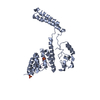 2c2lS C: citing same article ( S: Starting model for refinement |
|---|---|
| Similar structure data |
- Links
Links
- Assembly
Assembly
| Deposited unit | 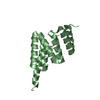
| ||||||||
|---|---|---|---|---|---|---|---|---|---|
| 1 |
| ||||||||
| Unit cell |
|
- Components
Components
| #1: Protein | Mass: 15733.964 Da / Num. of mol.: 1 / Fragment: TPR domain Source method: isolated from a genetically manipulated source Source: (gene. exp.)   References: UniProt: Q9WUD1, Ligases; Forming carbon-nitrogen bonds; Acid-amino-acid ligases (peptide synthases) |
|---|---|
| #2: Protein/peptide | Mass: 858.890 Da / Num. of mol.: 1 / Source method: obtained synthetically / Details: The peptide was chemically synthesized. / Source: (synth.)  Homo sapiens (human) / References: UniProt: P0DMV8*PLUS Homo sapiens (human) / References: UniProt: P0DMV8*PLUS |
| #3: Water | ChemComp-HOH / |
-Experimental details
-Experiment
| Experiment | Method:  X-RAY DIFFRACTION / Number of used crystals: 1 X-RAY DIFFRACTION / Number of used crystals: 1 |
|---|
- Sample preparation
Sample preparation
| Crystal | Density Matthews: 2.02 Å3/Da / Density % sol: 39.09 % |
|---|---|
| Crystal grow | Temperature: 294 K / Method: vapor diffusion, hanging drop / pH: 7 Details: 100mM Bis-tris propane pH 7.0, 40% PEG MME 2000, 3% (w/v) xylitol, VAPOR DIFFUSION, HANGING DROP, temperature 294K |
-Data collection
| Diffraction | Mean temperature: 100 K |
|---|---|
| Diffraction source | Source:  SYNCHROTRON / Site: SYNCHROTRON / Site:  SSRF SSRF  / Beamline: BL17U / Wavelength: 0.97924 Å / Beamline: BL17U / Wavelength: 0.97924 Å |
| Detector | Type: MARMOSAIC 225 mm CCD / Detector: CCD / Date: Jul 12, 2009 |
| Radiation | Monochromator: GRAPHITE / Protocol: SINGLE WAVELENGTH / Monochromatic (M) / Laue (L): M / Scattering type: x-ray |
| Radiation wavelength | Wavelength: 0.97924 Å / Relative weight: 1 |
| Reflection | Resolution: 1.54→33.7 Å / Num. all: 20426 / Num. obs: 20035 / % possible obs: 99.8 % / Observed criterion σ(F): 0 / Observed criterion σ(I): 0 / Redundancy: 7.5 % / Rmerge(I) obs: 0.062 / Net I/σ(I): 52.2 |
| Reflection shell | Resolution: 1.54→1.57 Å / Redundancy: 6.6 % / Rmerge(I) obs: 0.195 / Mean I/σ(I) obs: 11.2 / % possible all: 99.7 |
- Processing
Processing
| Software |
| ||||||||||||||||||||||||||||||||||||||||||||||||
|---|---|---|---|---|---|---|---|---|---|---|---|---|---|---|---|---|---|---|---|---|---|---|---|---|---|---|---|---|---|---|---|---|---|---|---|---|---|---|---|---|---|---|---|---|---|---|---|---|---|
| Refinement | Method to determine structure:  MOLECULAR REPLACEMENT MOLECULAR REPLACEMENTStarting model: 2C2L Resolution: 1.543→33.678 Å / SU ML: 0.15 / σ(F): 0.12 / Stereochemistry target values: ML
| ||||||||||||||||||||||||||||||||||||||||||||||||
| Solvent computation | Shrinkage radii: 0.9 Å / VDW probe radii: 1.11 Å / Solvent model: FLAT BULK SOLVENT MODEL / Bsol: 77.083 Å2 / ksol: 0.362 e/Å3 | ||||||||||||||||||||||||||||||||||||||||||||||||
| Displacement parameters |
| ||||||||||||||||||||||||||||||||||||||||||||||||
| Refinement step | Cycle: LAST / Resolution: 1.543→33.678 Å
| ||||||||||||||||||||||||||||||||||||||||||||||||
| Refine LS restraints |
| ||||||||||||||||||||||||||||||||||||||||||||||||
| LS refinement shell | Refine-ID: X-RAY DIFFRACTION / Total num. of bins used: 7
|
 Movie
Movie Controller
Controller



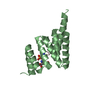
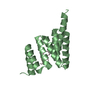
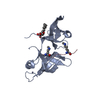
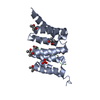
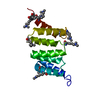
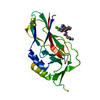
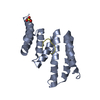
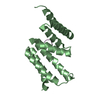
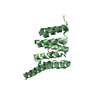
 PDBj
PDBj














